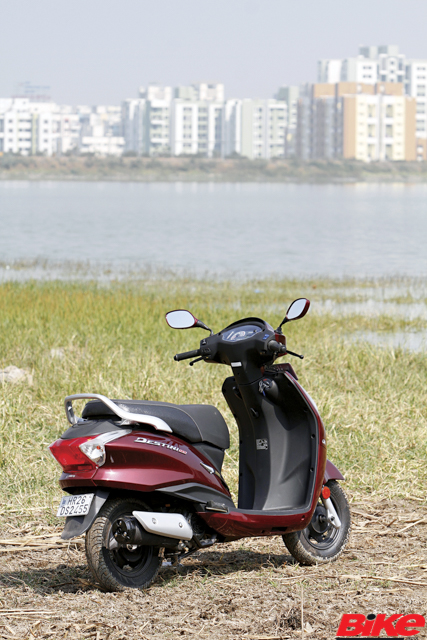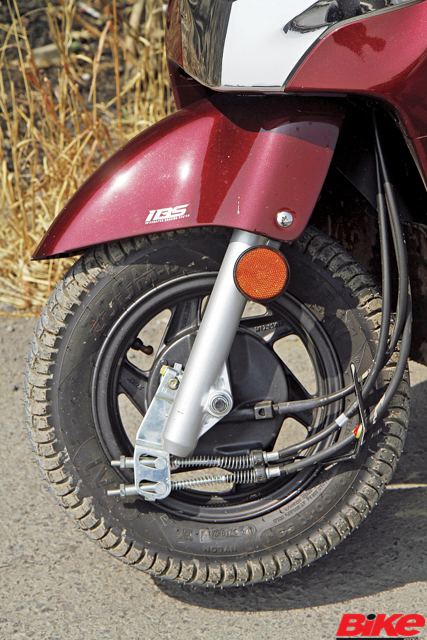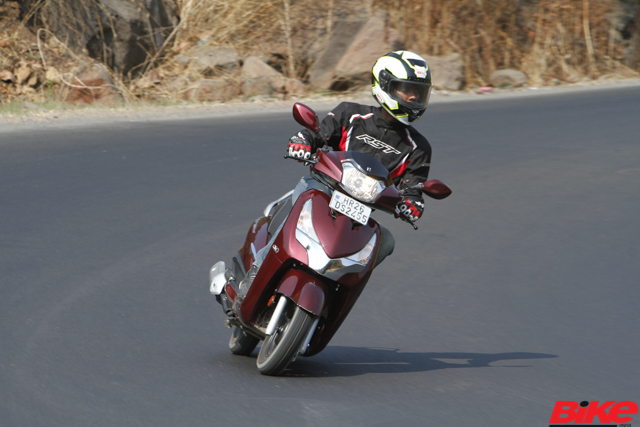
Powering the Destini is a capable 124.6-cc, air-cooled, single-cylinder engine that produces 8.84 PS at 6,750 rpm and a peak torque of 10.2 Nm at 5,000 rpm. All this power is sent to the rear wheel via a variomatic drive. Like most modern scooters, the Destini also gets a telescopic fork at the front while the rear is managed by a single hydraulic coil spring. The suspension is well set up and offers a plush ride in the city without inducing twitchy handling around corners. Braking duties are taken care of by drum units at either end along with the reassurance of Integrated Braking System. A system that links the rear brake to the front brake. It irks me that there is no option of a disc brake at the front, but that may be due to cost optimization.
 Moving on to convenience, the under-seat storage is large enough to hold a helmet and has enough space to accommodate a little grocery shopping. It even comes with a lamp and a mobile-phone charger. Another thoughtful feature is that you do not have to pull the key out of the ignition to open the seat or the fuel cap (located just below the pillion grab-rail).
Moving on to convenience, the under-seat storage is large enough to hold a helmet and has enough space to accommodate a little grocery shopping. It even comes with a lamp and a mobile-phone charger. Another thoughtful feature is that you do not have to pull the key out of the ignition to open the seat or the fuel cap (located just below the pillion grab-rail).
What I like best about the Destini is just how easy it is to ride. At 111.5 kg, it is a tad heavy (Suzuki’s Access 125 is almost 10 kg lighter) but the weight has been balanced well and the smooth, linear, and progressive throttle response makes navigating through traffic an easy affair. Having had enough of busy, straight roads, I pointed the Destini towards the hills. While the scooter struggled slightly to power out of uphill corners, it was remarkably quick to turn in and even held the line without any fuss. Once tipped in, the CEAT Zoom D tyres gave me enough confidence to get on the gas early and exit corners with the throttle wide open.
As I mentioned earlier, the Destini comes with Hero’s i3S and is the first scooter in their line-up to receive this system. When activated, the engine cuts off within five seconds after you roll to a stop. To start the engine again, all you have to do is hold the brake and twist the throttle. Quite a useful feature when one has to stop at a traffic light. However, it can get annoying if you are stuck in stop-and-go traffic and that is, perhaps, why there is a switch to turn it off completely.
We slapped on some testing equipment and put the Destini through its paces. Off the line, it dismisses 0-60 km/h in 7.78 seconds (marginally slower than the Honda Activa 125) and continues to pull strongly until close to 85 km/h before becoming slightly breathless. With a clear patch of road, we were able to achieve a top speed of 97.74 km/h. As for braking, we were able to roll to a stop from 80 km/h in 35.52 metres within 3.12 seconds. That is not bad at all, is it?

We rode the top-of-the-line VX model which is priced at Rs 57,500 (ex-showroom) and is the most premium Hero scooter right now. At that price, it is more accessible than most of its rivals such as the Honda Activa 125 and the Suzuki Access 125. While Hero have entered the 125-cc scooter segment rather late, they have made a smart move by pricing the Destini aggressively and targeting those customers looking for a family scooter. Of course, that is not an invitation to ferry more than two people on it at a time.


Leave a Reply